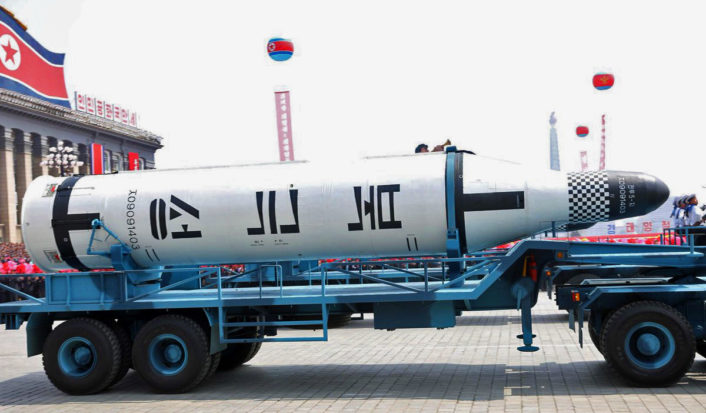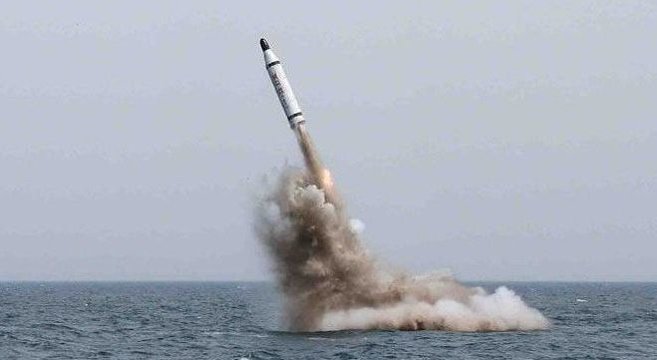North Korean Missile Test Failure Raises Theories, But Expert Disagrees.
The recent failure of the Sunday, April 17 North Korean submarine launched ballistic missile test raises an interesting question: Could the United States be responsible for the failure of North Korean missile tests? While the theory is alluring and some political sources are quoted as it being possible, one noted expert says he has seen nothing to suggest the U.S. intervened in the North Korean test failure.
Reports from the US Pacific Command at Camp H.M. Smith in Aiea, Hawaii under Chief of Staff Major General Kevin B. Schneider, USAF, say the U.S. detected a North Korean missile launch at 5:21 p.m. Eastern U.S. time zone on Saturday. The launches were seen at 11:21 AM Hawaiian time (21:21 GMT) said US Navy Commander Dave Benham, spokesman for United States Pacific Command.
Surveillance indicated the missile failed almost immediately.
A similar North Korean missile test was conducted earlier on April 5, 2017 and also failed along with another Mar. 5 North Korean missile test failure. All of the missiles encountered terminal problems in flight. These conspicuous failures follow a powerful U.S. initiative to develop clandestine anti-missile capabilities under the Obama administration beginning in 2014.
While there is no published evidence to support the theory that the United States directly interfered with the North Korean missile test, network media including CNN and the BBC have published speculative reports about whether the capability to remotely interdict a missile launch exists and was used.
“There is a very strong belief that the US, through cyber methods, has been successful on several occasions in interrupting these sorts of tests and making them fail,” former British Foreign Secretary Malcolm Rifkind told the BBC World News.
The Aviationist.com spoke to Dr. Bruce Emerson Bechtol Jr., Professor at the Department of Security Studies at Angelo State University, San Angelo, Texas in the United States.
In addition to his Ph.D. in National Security Studies from The Union Institute in Cincinnati, Ohio Dr. Bechtol was the Distinguished Graduate of the U.S. Marine Corps Command and Staff College where he earned his pre-doctorate Masters Degree in Military Studies in 2001. Bechtol also owns a Master of Arts in International Affairs from Catholic University in Washington D.C. He is a noted authority on North Korean military capabilities. We asked Dr. Bechtol about the possibilities that the U.S. could have actively disrupted North Korean missile tests.
“There is nothing to support that.” Dr. Bechtol told us when we asked him about the plausibility of direct U.S. interdiction of the North Korean missile test. “I mean, it is certainly possible, but I have seen nothing to support that. All I have heard is conjecture. The media likes to talk about that.”

Dr. Bechtel told us that ballistic missile programs are inherently dependent on numbers. “It’s like the SCUD missile. Typically, of 600 of those fired, you get 150-200 duds. That’s normal, but the intention is to shower a target with missiles. And remember, if you are attacking Hawaii with a nuclear warhead, you don’t have to be that accurate, you just have to get one through.”
Another change in newer North Korean missiles noted by Dr. Bechtel was newer guidance fins. When asked what the guidance capabilities of the North Korean’s ballistic missiles are, Bechtel told us, “Well, I wish we knew. But one thing is for sure; the North Koreans are not noted for accuracy in their ballistic missiles. They don’t have to be.”
The failure may also have been a part of a historically difficult development program for North Korea’s missiles. But just as North Korea has had somewhat sporadic successes in their missile launch tests, the U.S. has also had at least sporadic success in testing systems to actively counter ballistic missiles. Even with Dr. Bechtel’s pragmatism there remains a remote chance that Sunday’s failure could have been a fortunate intersection of capabilities for the U.S. It also may have been continued North Korean bad luck. Among U.S. defense officials, the silence is deafening.
While Dr. Bechtel’s remarks suggest otherwise, a North Korean submarine launched missile test could theoretically be disrupted several ways. “I guess, you mean, something like Stuxnet is theoretically possible, but I haven’t seen any proof.” Stuxnet was a 2010 computer worm that disrupted Iran’s nuclear program. It is attributed to American-Israeli origin.
The least exotic method of passive missile interdiction is sabotage. This could occur at the missile assembly site or during transport of the missile or its components. Since North Korean missile programs are dependent on foreign technology they are highly vulnerable to sabotage throughout their development.
Current North Korean missile technology is derived from a combination of Chinese, Russian and Iranian technologies. Each of these foreign technology origins is “porous” to foreign espionage not only from the United States but also from Israel and the United Kingdom. It took China about 15 years to achieve its current level of development in ballistic missiles. North Korea has achieved a similar level of technology in only 123 days of advanced development, reinforcing the theory that most of the technology is imported, not indigenous. Given a seemingly new era of détente between the U.S. and China, including recent meetings between U.S. President Donald Trump and Chinese President Xi Jinping, it is possible that a two-way sharing of technology between the U.S. and China has been brokered. This may further facilitate U.S. efforts to sabotage North Korean missile capabilities.
Interestingly, an Iranian ballistic missile test on Jan. 25, 2017 also failed shortly after launch. According to a US official speaking on condition of anonymity, the Iranian medium-range ballistic missile exploded in flight. But Dr. Bechtel continued to temper speculation with fact, “There were four SCUDs recently tested by North Korea that were successful. These recent failures don’t’ lesson the threat.”
The failed North Korean missile test on Sunday was possibly a version of the Pukguksong-1 submarine launched ballistic missile (SLBM). This missile is boosted to the ocean surface from a submerged launch platform using either compressed air or a booster motor. Once it clears the surface the missile’s solid fuel motor ignites and it begins its flight.
North Korea has launched SLBM’s from both submerged test barges and from submarines. Part of the reason some tests were conducted from submerged barges is that launching missiles from a submerged vehicle is inherently dangerous. Reports indicate at least one North Korean submarine was seriously damaged during a missile launch test, suggesting a reason for why early tests were launched from a submerged barge instead of a submarine.

A more exotic theory about how the U.S. could disrupt a North Korean ballistic missile in flight is some type of active intervention during the test, as opposed to sabotage prior to the test.
Active interdiction of missile tests may include somewhat plausible methods such as electronic disruption of the missile’s guidance systems causing it to fly out of control and disintegrate, or more exotically, some type of focused energy weapon. Both of these technologies have been tested to greater and lesser degrees of published success. A key thing to consider when evaluating any of these theories is that advanced active jamming and destructive methods remain most effective when they are still secret. As long as these technologies remain covert it is more difficult- or impossible- for North Korea to engineer around them.
Some media outlets have suggested that North Korean systems are vulnerable to “hacking” or a cyber attack. While possible, cyber attacks depend on a “delivery vehicle” to implant malicious programming code into microchips or insertion via a virus. The Stuxnet weaponized code was inserted via a USB flashdrive.
China has devoted significant military and intelligence resources to cyber warfare but has little motive to employ those resources against neighboring North Korea- except to build leverage with the United States.
The U.S. also has highly developed cyber combat resources in addition to the early Stuxnet. These may include what is referred to as “left of launch” attacks. Some of these may even be interdiction of a ballistic missile while it is still underwater. One published technical report about electromagnetic propagation mentions the “Wireless, through-hull transfer of power and data”. This transfer is “highly focused” and ranges in excess of 1 km are discussed in unclassified reports dating as long ago as 2008 from submarine industry news source Hydro International. It is reasonable to suggest significant advances have been made in all of these technologies during the past 9 years, especially given the focus during the previous U.S. President’s adminstration.
Regardless of theories about possible test interdiction from the U.S., the North Korean weapons tests and their accelerated preparation have become increasingly ominous. Both media and political rhetoric has shifted from “if” there will be a military confrontation with North Korea, to “when” it will actually begin.
Top image: (computer generated) image of a North Korean SLBM (Rodong Sinmun via NK News)









